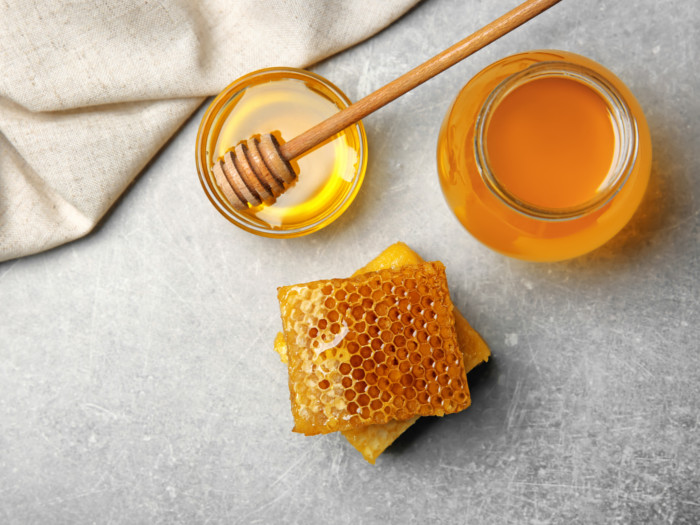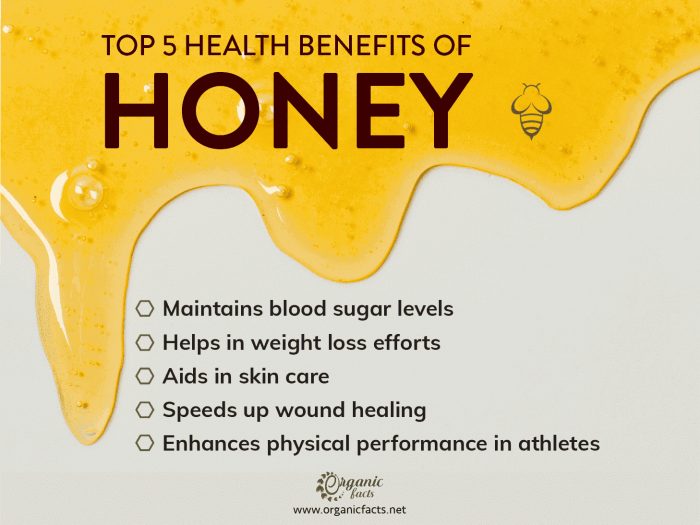Honey has been used by countless cultures all around the world over the past 2,500 years. While the numerous health benefits of honey have made it an important element of traditional medicines such as Ayurvedic treatments, scientists are also researching its benefits concerning modern medicine, particularly in the healing of wounds.
Honey is a great source of antioxidants, which help in fighting free radicals. It also has antibacterial and anti-fungal properties and is known to be good for coughs and cold.
It is known as Honig in German, Miele in Italian, Shahad in Hindi, Miel in French and Spanish, Mel in Portuguese, мед in Russian, Honing in Dutch, and μελι in Greek. There is almost no part of the world where honey is not widely used and celebrated as a part of the cultural diet.
But what makes it so popular? Most likely, it is the ease with which it can be consumed. One can eat it directly, put it on bread like a jam, use it in place of sugar in juices, or mix it with warm water, lime juice, cinnamon, and other herbs for homemade medicine. It is preferred for its taste as well as health benefits, making it extremely useful and versatile.
Health Benefits of Honey
Its benefits include the following treatments, taken from both traditional and modern medical experts.
Healthy Sweetener
It can be used as a substitute for sugar in many foods and drinks. It contains about 69% glucose and fructose, enabling it to be used as a sweetener which is far better for your overall health than normal white sugar. [1]
Honey also contains a variety of vitamins and minerals. The type of vitamins and minerals and their quantity depends on the type of flowers used for apiculture. Commonly, honey contains vitamin C, calcium, and iron. The vitamin and mineral content in regular sugar, on the other hand, is completely insignificant.
Weight Loss
Honey is known to be effective for reducing weight as it has a low glycemic index, which helps in controlling weight gain and fat accumulation. It also fights obesity by lowering blood glucose levels and improving lipid metabolism, thereby also preventing the risk of metabolic syndrome (metabolic syndrome causes obesity). To learn more about how honey helps with weight loss, you can read our article on the same – Is Honey Good For Weight Loss. [2]
Provides Cough Relief
In 2012 a research was conducted on 300 children (1 to 5 years) to find out the effect of honey on nocturnal cough and sleep quality. The results published in the Pediatrics Journal showed that it could be a preferable treatment for a cough and sleep difficulty associated with childhood upper respiratory tract infections (URIs). [3]
Another research suggests that giving 1.5 tsp of honey to kids before bedtime can be an effective cough remedy. You can also try making honey tea for the same – Honey Tea: Benefits & How To Make.
[4]
Boosts Energy
According to the USDA, honey contains about 64 calories per tablespoon. Therefore, it is used by many people as a source of energy. On the other hand, one tablespoon of sugar will give you about 15 calories. Furthermore, the carbohydrates in it can be easily converted into glucose, since it is very simple for the body to digest this pure and natural substance. For the same reason, it is also known to improve athletic performance. [5]

Honey has been used for medicinal purposes since ancient times. Photo Credit: Shutterstock
Serving Size : Nutrient Value Water [g] 17.1 Energy 304 Energy [kJ] 1272 Protein [g] 0.3 Ash [g] 0.2 Carbohydrate, by difference [g] 82.4 Fiber, total dietary [g] 0.2 Sugars, total including NLEA [g] 82.12 Sucrose [g] 0.89 Glucose (dextrose) [g] 35.75 Fructose [g] 40.94 Maltose [g] 1.44 Galactose [g] 3.1 Calcium, Ca [mg] 6 Iron, Fe [mg] 0.42 Magnesium, Mg [mg] 2 Phosphorus, P [mg] 4 Potassium, K [mg] 52 Sodium, Na [mg] 4 Zinc, Zn [mg] 0.22 Copper, Cu [mg] 0.04 Manganese, Mn [mg] 0.08 Selenium, Se [µg] 0.8 Fluoride, F [µg] 7 Vitamin C, total ascorbic acid [mg] 0.5 Riboflavin [mg] 0.04 Niacin [mg] 0.12 Pantothenic acid [mg] 0.07 Vitamin B-6 [mg] 0.02 Folate, total [µg] 2 Folate, food [µg] 2 Folate, DFE [µg] 2 Choline, total [mg] 2.2 Betaine [mg] 1.7 Tryptophan [g] 0 Threonine [g] 0 Isoleucine [g] 0.01 Leucine [g] 0.01 Lysine [g] 0.01 Methionine [g] 0 Cystine [g] 0 Phenylalanine [g] 0.01 Tyrosine [g] 0.01 Valine [g] 0.01 Arginine [g] 0.01 Histidine [g] 0 Alanine [g] 0.01 Aspartic acid [g] 0.03 Glutamic acid [g] 0.02 Glycine [g] 0.01 Proline [g] 0.09 Serine [g] 0.01 Sources include : USDA [6]
Improving Memory
Honey contains polyphenols that can significantly improve the memory-related functions of the brain. It counters deficits in recall functions and induces memory formation at the molecular level. It is this modulation of neural circuitry that helps in improving memory. Research on Tualang honey, multi-floral honey found in Malaysia, found that its intake improves the brain morphology to improve various learning and memory functions. [7] [8]
Antiseptic Property
When applied topically on wounds, honey has anti-bacterial and anti-fungal properties. It is often used as a natural antiseptic in traditional medicines. In-vitro tests on different medical-grade kinds of honey showed potent bactericidal activity even in the presence of antibiotic-resistant bacteria that infections in humans. However, the antimicrobial activity depends on the source of nectar. [9] [10] [11]
Antioxidant Properties
It contains nutraceuticals, which are very effective for the removal of free radicals from the body. As a result, our body’s immunity is improved against many chronic health conditions. A study on the antioxidant properties of honey, published in the Journal of Agricultural and Food Chemistry, attributed these qualities to the presence of a wide range of compounds, which include phenolics, peptides, Maillard reaction products, organic acids, enzymes, and other minor components. [12] [13] [14]
Skin and Hair Care
Milk and honey are often served together since both of these ingredients help in creating smooth, beautiful skin. Consuming this combination every morning is a common practice in many countries for this very reason. A study published in the European Journal of Medical Research investigated and confirmed the use of honey for dandruff and dermatitis. It said that crude honey could markedly improve seborrheic dermatitis, its associated hair loss, and prevent relapse when applied weekly. [15]
It is also used in various cosmetics, including face washes, moisturizers, shampoos, and hair conditioners, as per research published in the Journal of Ayurveda. [17]

Honey has been used by countless cultures all around the world over the past 2,500 years.
Speeds Wound Healing
Significant research is being carried out to study its benefits in the treatment of wounds. These have been listed below:
- It possesses antimicrobial properties. [18]
- It helps in promoting autolytic debridement. [19]
- It deodorizes malodorous wounds. [20]
- It speeds up the healing process by stimulating wound tissues. [21]
- It helps in initiating the healing process in dormant wounds.
- It also helps in promoting moist wound healing.
These healing powers are not overstated. The Waikato Honey Research Unit provides details about the worldwide research that is being carried out on the benefits of honey in medicine. Such research will provide scientific evidence for the beliefs held by honey lovers all over the world and will help in propagating the benefits to more people. [22]
Now that you know the benefits, how do you eat it? You can eat it raw, add it to water or different beverages, and you can also add it to several recipes.
Factors Governing the Benefits
Not all honey is created equally, so the quality is different. Both the price and the health benefits of honey are dependent on its quality, so it has become very important for the manufacturers and consumers to understand the various factors that affect the quality of honey. Some of these factors include the type of flowers used in the formation of the honeycombs, the blending process, storage conditions, the temperature of heating, and more. These factors have been explained below in more detail
Type of flowers: While it has many qualities, its properties are also decided by its source. A study published in the Asian Pacific Journal of Tropical disease found that the source of honey influenced its properties. Different types of honey showed varying degrees of antibacterial activity. Clover honey showed the highest antibacterial activity, followed by citrus honey and cotton honey respectively.
Blending: Polyfloral honey (which is obtained from more than one flower) is more beneficial than monofloral. Hence, many companies are today selling blended honey as it offers multiple benefits.
Storage: When stored for a long duration, it becomes darker in color. It loses some of its properties and may also ferment if the water content is too high. Therefore, prolonged storage should be avoided. Newly harvested honey should be preferred when you are using it for the above-mentioned benefits.
Heating: Heating leads to drastic changes in its chemical composition. As a result, heating at high temperatures reduces its benefits. This is why many people prefer raw, organic, or raw organic honey. Raw by definition signifies less processing (and no heating). Organic honey is prepared using stringent organic production methods and processing standards, in which heating at high temperatures is not allowed.
Water Content: It can also undergo fermentation. If the water content is high (above 19%), the chances of it becoming fermented are high. You can measure the water content using a refractometer. Furthermore, freely flowing honey either contains higher water content or has been heated to disturb the natural crystallization process, thereby reducing the benefits it will confer to you.
Color: The color of honey is one way of judging its quality. Light-colored honey is usually preferred as it has a milder flavor. It can also be dark in color but it has a stronger flavor because of the flowers the bees collect it from.
Filtration: Most of the benefits are due to the presence of the pollen within the honey. Without the pollen, it is a glucose-fructose solution and is just as bad for you as sugar. Unfortunately, companies market the transparent clear product as good quality, while in reality, ultra-filtered honey does not have many health benefits at all. That being said, you should be very cautious while consuming pollen-rich honey. If you have a pollen allergy, avoid consuming it.
Caution
Contamination
It can be contaminated with the pesticides sprayed on crops through one or more of the following ways:
- In some cases, when the plants and weeds containing flowers have been sprayed with pesticides, the bees get poisoned too.
- At times, the pesticide is sprayed on the bees directly.
- In many cases, the bees collect nectar and pollen that is contaminated with pesticides.
- When pesticides are sprayed, part of the amount is accumulated in the water on or near the plants. When the bees drink this water, they are also affected.
- On some occasions, the pesticide gets sprayed on the beehives or gets transported to it from the sprayed plants.
Residues of Antibiotics
What leads to antibiotic contamination? Unlike organic production, conventional honey production does not involve stringent guidelines for the quantity and mode of transmission of antibiotics to the bees. As a result, apiculturists have a free hand when using these antibiotics. When farmers use excessive quantities of antibiotics the chance of contamination increases.
What is the problem with residues of antibiotics being found in honey? The antibiotics given to the bees are veterinary antibiotics such as chloramphenicol, streptomycin, and sulfonamides. Large doses of chloramphenicol may cause aplastic anemia in humans. Similarly, high doses of streptomycin and sulfonamides are harmful too. [23]
Many countries have not banned the use of these harmful drugs in apiculture. The EU has banned all three while the US has only banned chloramphenicol to date.
